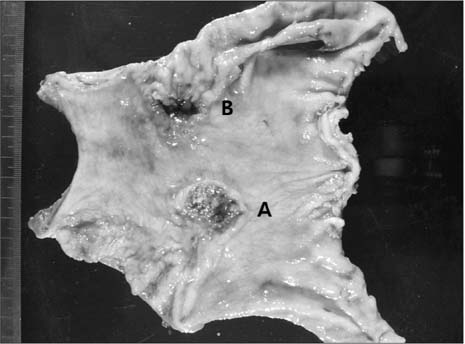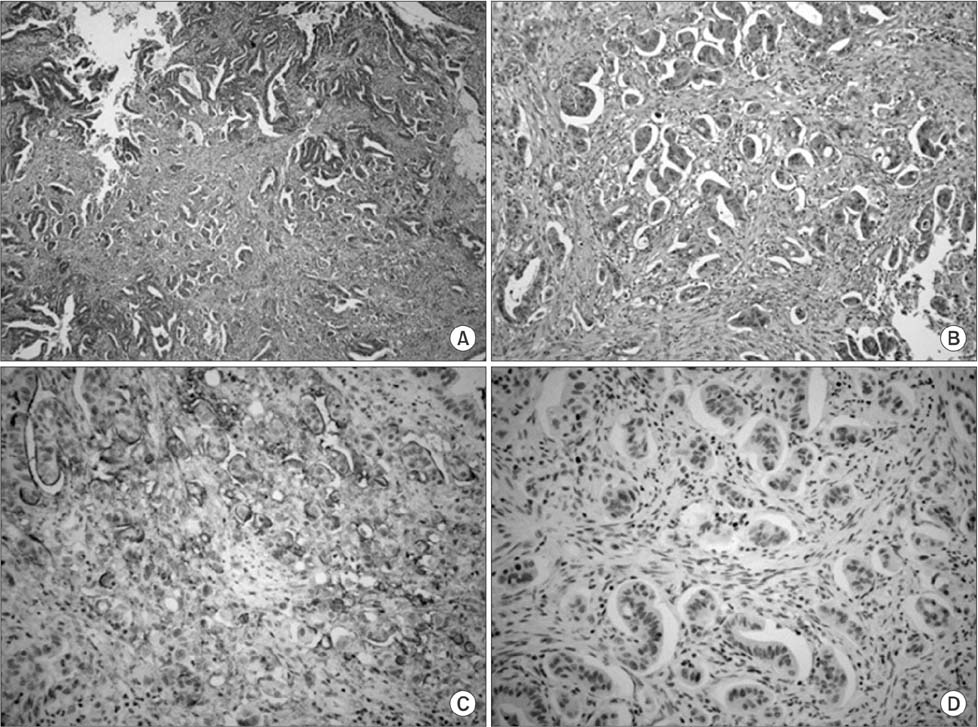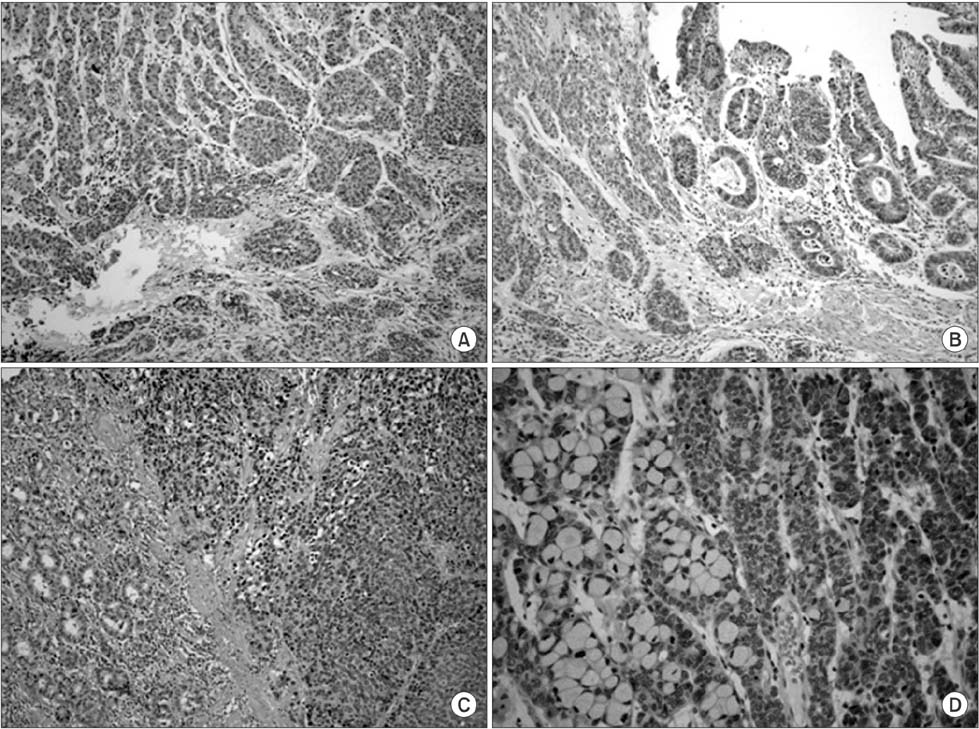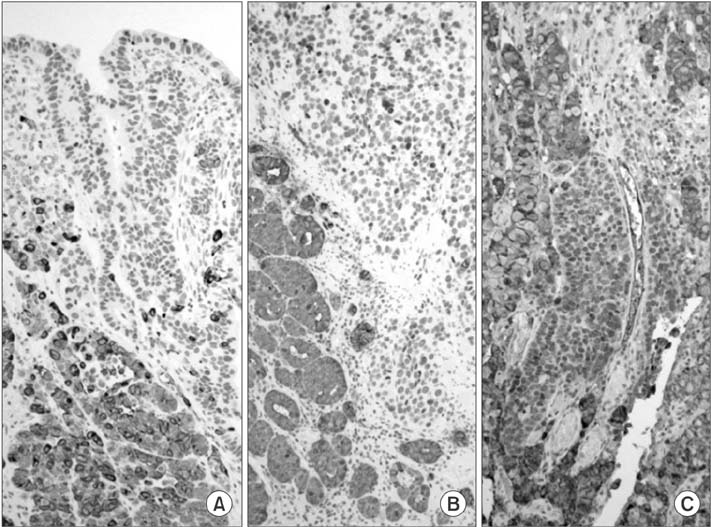J Gastric Cancer.
2016 Dec;16(4):266-270. 10.5230/jgc.2016.16.4.266.
A Concurrence of Adenocarcinoma with Micropapillary Features and Composite Glandular-Endocrine Cell Carcinoma in the Stomach
- Affiliations
-
- 1Department of Surgery, Gangneung Asan Hospital, University of Ulsan College of Medicine, Gangneung, Korea.
- 2Department of Pathology, Gangneung Asan Hospital, University of Ulsan College of Medicine, Gangneung, Korea. edwjyh@gnah.co.kr
- KMID: 2389853
- DOI: http://doi.org/10.5230/jgc.2016.16.4.266
Abstract
- We report a unique case of synchronous double primary gastric cancer consisting of adenocarcinoma components with micropapillary features and composite glandular-endocrine cell carcinoma components. The patient was a 53-year-old man presenting with a 6-month history of epigastric pain and diarrhea. A subtotal gastrectomy was performed. Histologically, one tumor was composed of micropapillary carcinoma components (50%) with tight clusters of micropapillary aggregates lying in the empty spaces, admixed with moderately differentiated adenocarcinoma components. MUC-1 was expressed at the stromal edge of the micropapillary component. The other tumor was composed of atypical carcinoid-like neuroendocrine carcinoma (50%), adenocarcinoid (30%), and adenocarcinoma components (20%). The neuroendocrine components were positive for CD56, synaptophysin, chromogranin, and creatine kinase. The adenocarcinoid components were positive for both carcinoembryonic antigen and neuroendocrine markers (amphicrine differentiation). This case is unique, due to the peculiar histologic micropapillary pattern and the histologic spectrum of adenocarcinoma adenocarcinoid-neuroendocrine carcinoma of the synchronous composite tumor.
Keyword
MeSH Terms
Figure
Reference
-
1. Shin HR, Jung KW, Won YJ, Park JG. 2002 annual report of the Korea Central Cancer Registry: based on registered data from 139 hospitals. Cancer Res Treat. 2004; 36:103–114.2. Bae JS, Lee JH, Ryu KW, Kim YW, Bae JM. Characteristics of synchronous cancers in gastric cancer patients. Cancer Res Treat. 2006; 38:25–29.3. Kodera Y, Yamamura Y, Torii A, Uesaka K, Hirai T, Yasui K, et al. Incidence, diagnosis and significance of multiple gastric cancer. Br J Surg. 1995; 82:1540–1543.4. Siriaunkgul S, Tavassoli FA. Invasive micropapillary carcinoma of the breast. Mod Pathol. 1993; 6:660–662.5. Lee JH, Kim JH, Choi JW, Kim YS. The presence of a micropapillary component predicts aggressive behaviour in early and advanced gastric adenocarcinomas. Pathology. 2010; 42:560–563.6. Eom DW, Kang GH, Han SH, Cheon GJ, Han KH, Oh HS, et al. Gastric micropapillary carcinoma: a distinct subtype with a significantly worse prognosis in TNM stages I and II. Am J Surg Pathol. 2011; 35:84–91.7. Sakamoto K, Watanabe M, De La, Honda H, Ise H, Mitsui K, et al. Primary invasive micropapillary carcinoma of the colon. Histopathology. 2005; 47:479–484.8. Nassar H, Pansare V, Zhang H, Che M, Sakr W, Ali-Fehmi R, et al. Pathogenesis of invasive micropapillary carcinoma: role of MUC1 glycoprotein. Mod Pathol. 2004; 17:1045–1050.9. Lewin K. Carcinoid tumors and the mixed (composite) glandular-endocrine cell carcinomas. Am J Surg Pathol. 1987; 11:Suppl 1. 71–86.10. Yang GC, Rotterdam H. Mixed (composite) glandular-endocrine cell carcinoma of the stomach. Report of a case and review of literature. Am J Surg Pathol. 1991; 15:592–598.
- Full Text Links
- Actions
-
Cited
- CITED
-
- Close
- Share
- Similar articles
-
- Composite Neuroendocrine Carcinoma with Adenocarcinoma of the Stomach Misdiagnosed as a Giant Submucosal Tumor
- Composite Carcinoma-Carcinoid Tumor of Stomach: Report of a case
- A Case of a Gastric Composite Tumor with an Adenocarcinoma and a Large Cell Neuroendocrine Carcinoma
- Gastric Collision Tumor (Adenocarcinoma and Neuro-endocrine Carcinoma): A Report of Two Cases
- A Case of Double Primary Cancer: Early Gastric Adenocarcinoma associated with Adenocarcinoma and Carcinoid





